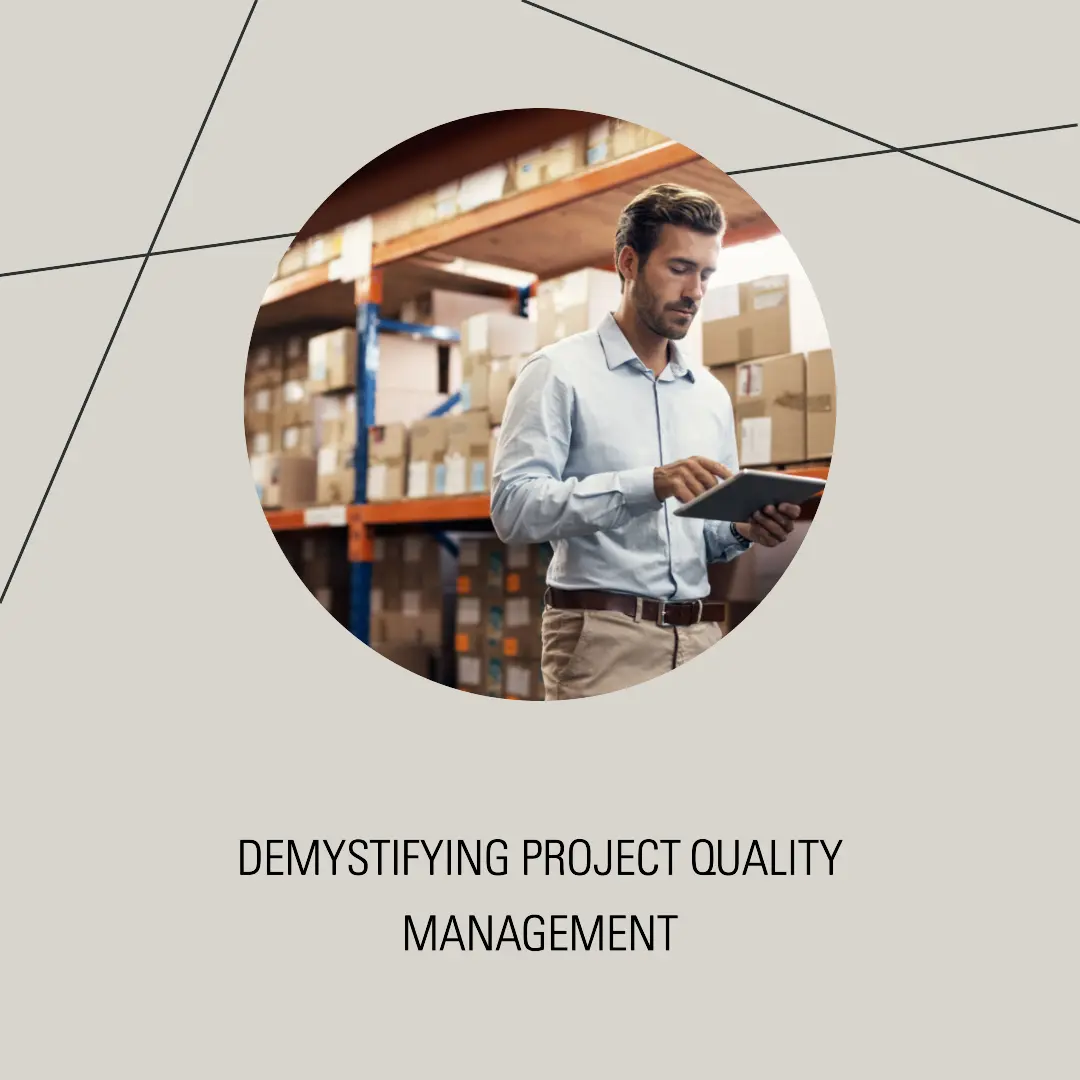I. Introduction
Hey there, fellow project enthusiasts! Let’s talk about something that often gets overlooked but plays a vital role in the success of any project: quality management. Ensuring that your project delivers top-notch results is crucial, not only for your reputation but also for the satisfaction of your clients and stakeholders. Today, we’re going to demystify the three main processes in project quality management, so you can take your projects to the next level. Get ready to dive into quality planning, quality assurance, and quality control!
Now, you might be wondering why these three processes are so important. The answer is simple: they work together to create a solid foundation for your project, ensuring that you meet or exceed the expectations of everyone involved. In other words, these processes help you deliver a project that’s the bee’s knees, the cat’s pajamas, the whole enchilada – you get the idea!
So, without further ado, let’s get started on our journey to becoming project quality management gurus! Grab your favorite cup of coffee (or tea, if that’s your thing), and let’s dive into the fascinating world of quality planning, quality assurance, and quality control. Here’s to making your projects shine like the stars they deserve to be!
II. Quality Planning
Alright, friends! It’s time to kick off our deep dive into the world of project quality management with the first of our three main processes: quality planning. This is where the magic begins, and it’s all about setting the stage for a successful project that meets or exceeds expectations.
A. Definition and purpose
So, what exactly is quality planning, and why should you care about it? In a nutshell, quality planning involves identifying the quality standards and objectives for your project and then developing a plan to achieve those goals. This process is all about being proactive, so you’re not just reacting to issues as they come up. Instead, you’re setting the stage for success from the very beginning.
B. Key components of quality planning
Now that we know what quality planning is, let’s dive into the nitty-gritty of what it entails. Here are the key components you’ll want to consider when developing your quality plan:
- Project scope and objectives: Start by defining the project’s scope and objectives clearly, so everyone involved knows exactly what’s expected. This is the foundation on which your entire quality plan will be built.
- Quality standards and benchmarks: Next, identify the quality standards and benchmarks relevant to your project. These could be industry-specific guidelines or even best practices from similar successful projects. Keep in mind that setting the bar high will motivate your team to strive for excellence.
- Quality management plan: Finally, develop a comprehensive quality management plan that outlines the processes and procedures your team will follow to ensure the project meets or exceeds the established quality standards.
C. Quality planning tools and techniques
As you’re working on your quality plan, you’ll want to leverage some tried-and-true tools and techniques to ensure you’re setting your project up for success. Here are a few you might consider:
- Cost-benefit analysis: This helps you weigh the potential benefits of a quality initiative against the costs involved, ensuring you’re making the best decisions for your project.
- Benchmarking: Compare your project to similar projects in your industry to identify best practices and areas where you can improve.
- Risk assessment: Identify potential risks to your project’s quality and develop strategies to mitigate those risks, so you’re prepared for any bumps in the road.
D. Best practices for effective quality planning
As you embark on your quality planning journey, keep these best practices in mind to help ensure your project is a smashing success:
- Engage stakeholders early and often, so everyone is on the same page regarding quality expectations.
- Be realistic and flexible when setting your quality standards and objectives, as circumstances may change during the project.
- Encourage a culture of continuous improvement, so your team is always striving for excellence.
And that, my friends, is quality planning in a nutshell! Now that we’ve laid the groundwork, it’s time to move on to the next critical process in project quality management: quality assurance. Let’s keep the momentum going!
III. Quality Assurance
Great job, folks! Now that we’ve nailed down quality planning, it’s time to explore the wonderful world of quality assurance. This is where we ensure that all our hard work in planning pays off, and our project runs like a well-oiled machine.
A. Definition and purpose
Quality assurance is all about making sure our project processes and deliverables meet the quality standards we’ve set during the planning stage. This proactive approach helps to identify and address potential issues before they snowball into bigger problems. Think of quality assurance as your project’s guardian angel, keeping a watchful eye on everything to ensure nothing falls through the cracks.
B. Key components of quality assurance
To effectively implement quality assurance, let’s take a look at its key components:
- Quality audits: Regularly review and assess your project’s processes to ensure they’re in line with the quality plan. Quality audits can help you identify areas for improvement, so you can make necessary adjustments before issues escalate.
- Process improvement: As you discover areas for improvement during your audits, work with your team to streamline and optimize your project processes. This continuous improvement mindset will keep your project running smoothly and efficiently.
- Quality metrics: Establish quantifiable measures to gauge your project’s performance against the established quality standards. These metrics will help you track progress and identify areas where extra attention may be needed.
C. Quality assurance tools and techniques
When it comes to quality assurance, there are a few tried-and-true tools and techniques you can rely on to keep your project on track:
- Statistical process control: Use statistical methods to analyze your project processes, so you can identify trends, patterns, and variations that may impact quality.
- Root cause analysis: When issues do arise, dig deep to uncover the underlying cause. This will help you address the root of the problem, rather than just treating the symptoms.
- Continuous improvement: Embrace a culture of ongoing improvement, where your team is always looking for ways to optimize processes and enhance project quality.
D. Best practices for effective quality assurance
Keep these best practices in mind as you implement quality assurance in your projects:
- Foster open communication and collaboration within your team, so everyone feels comfortable discussing potential quality issues and solutions.
- Make quality assurance an ongoing effort, rather than a one-time event. Regular check-ins and audits will help ensure your project stays on track.
- Celebrate your team’s successes and learn from any setbacks, so you can continually refine your project processes and deliver top-notch results.
And there you have it – quality assurance demystified! Now that we’ve covered the first two processes in project quality management, it’s time to bring it all home with the final piece of the puzzle: quality control. Let’s wrap this up and get ready to conquer our projects with confidence!
IV. Quality Control
We’ve made it, friends! It’s time to tackle the final process in our project quality management journey: quality control. With quality planning and quality assurance under our belts, we’re now ready to put all that hard work to the test and make sure our project deliverables are top-notch.
A. Definition and purpose
Quality control is all about checking and verifying that your project’s deliverables meet the established quality standards. It’s the process of identifying any defects, errors, or inconsistencies and taking corrective action to address them. Essentially, quality control is your project’s final line of defense, ensuring that everything is up to snuff before it reaches your clients or stakeholders.
B. Key components of quality control
To master quality control, let’s explore its key components:
- Inspection and testing: Regularly inspect and test your project deliverables against the quality standards you’ve set. This will help you catch any defects or errors early, allowing you to address them before they become major issues.
- Defect tracking and resolution: Establish a system for tracking and resolving any defects or errors discovered during the inspection and testing process. This will help ensure that issues are promptly addressed and don’t slip through the cracks.
- Performance monitoring: Continuously monitor your project’s performance against the established quality metrics. This will help you identify any trends or patterns that may require additional attention or corrective action.
C. Quality control tools and techniques
Arm yourself with these proven tools and techniques to help you effectively implement quality control in your projects:
- Control charts: Use control charts to monitor the performance of your project processes over time, helping you identify any trends, patterns, or variations that may impact quality.
- Pareto analysis: Apply the Pareto principle (also known as the 80/20 rule) to prioritize the most critical issues impacting your project’s quality. This will help you focus your efforts where they’ll have the greatest impact.
- Cause and effect diagrams: Also known as Ishikawa or fishbone diagrams, these visual tools can help you identify and analyze the root causes of quality issues, so you can address them effectively.
D. Best practices for effective quality control
As you implement quality control in your projects, keep these best practices in mind to ensure success:
- Foster a culture of accountability and ownership within your team, so everyone takes responsibility for the quality of their work.
- Be proactive in addressing any defects or errors, rather than waiting for them to become significant issues.
- Communicate openly and transparently with your team, clients, and stakeholders about the status of quality control efforts and any challenges or successes you encounter.
And there you have it – quality control demystified! With quality planning, quality assurance, and quality control under your belt, you’re now fully equipped to tackle project quality management like a pro. Let’s go forth and make our projects shine!
V. Integrating the Three Processes in Project Quality Management
Congratulations, my project aficionados! We’ve conquered the individual processes of quality planning, quality assurance, and quality control. Now it’s time to bring it all together and discuss how these processes integrate seamlessly to create a rock-solid project quality management approach. Let’s dive in!
A. The importance of communication and collaboration
One of the keys to successful project quality management is fostering open communication and collaboration among your team members. When everyone is on the same page and working towards a common goal, you create an environment where quality can truly thrive. Encourage your team to share their ideas, challenges, and successes, and remember that collaboration is a two-way street – be open to feedback and suggestions from others.
B. Aligning processes with project goals and objectives
Each of the three processes in project quality management – quality planning, quality assurance, and quality control – should be aligned with your project’s overall goals and objectives. This ensures that every aspect of your project is laser-focused on achieving the desired outcomes. Regularly review and adjust your quality processes as needed to keep them in line with your project’s evolving needs and priorities.
C. Continuous improvement and learning
Embracing a mindset of continuous improvement and learning is essential to successful project quality management. This means always looking for ways to optimize your processes, address issues more effectively, and enhance the quality of your project deliverables. Encourage your team to be proactive in identifying areas for improvement and to learn from both their successes and setbacks. This growth-oriented mindset will help ensure that your projects continue to improve over time, setting you up for long-term success.
And there you have it, folks – the grand finale of our project quality management exploration! By integrating quality planning, quality assurance, and quality control, you’ve created a comprehensive approach to ensuring the highest quality in your projects. As you move forward, remember the importance of communication, collaboration, and continuous improvement. You’re now fully prepared to tackle your projects with confidence and achieve amazing results. Here’s to delivering exceptional quality and making our projects the best they can be!
VI. Conclusion
Wow, what an adventure we’ve had together, my fellow project enthusiasts! We’ve explored the ins and outs of the three main processes in project quality management – quality planning, quality assurance, and quality control – and we’ve learned how to effectively integrate them to achieve outstanding results in our projects. It’s been a pleasure being your guide on this journey, and I’m excited to see the amazing things you’ll accomplish with your newfound knowledge.
Let’s take a moment to recap the key takeaways from our deep dive into project quality management:
- Quality planning sets the stage for success by defining your project’s quality standards, objectives, and management plan.
- Quality assurance proactively monitors and improves your project processes to ensure they align with your quality plan.
- Quality control focuses on verifying that your project deliverables meet the established quality standards and taking corrective action when needed.
By mastering and integrating these three processes, you’ll be well-equipped to deliver projects that not only meet but exceed the expectations of your clients and stakeholders. Remember, project quality management isn’t just about checking boxes or meeting minimum requirements – it’s about striving for excellence and consistently delivering the best possible results.
So, as we wrap up this exciting journey, I encourage you to embrace the principles of quality planning, quality assurance, and quality control in your own projects. Keep communication, collaboration, and continuous improvement at the heart of your approach, and watch your projects soar to new heights. You’ve got this, and I’m cheering you on every step of the way!
Here’s to your success, and happy project managing!
To find out how Artificial Intelligence is changing the Project Management landscape, you have enjoy reading this article https://www.shaunstoltz.com/did-artificial-intelligence-just-change-everything-about-project-management/
Find out more about Shaun Stoltz https://www.shaunstoltz.com/about/
This post was written by an AI and reviewed/edited by a human.



